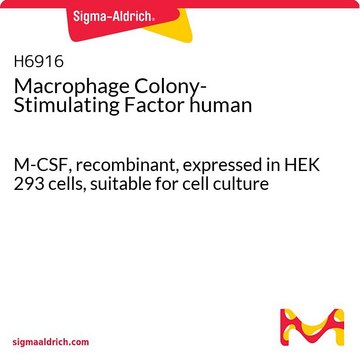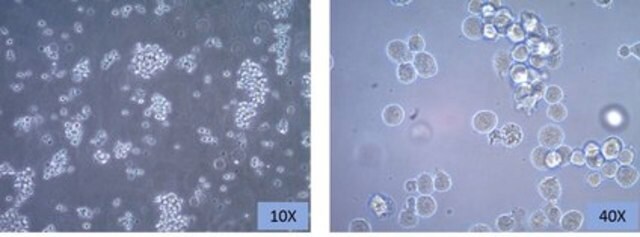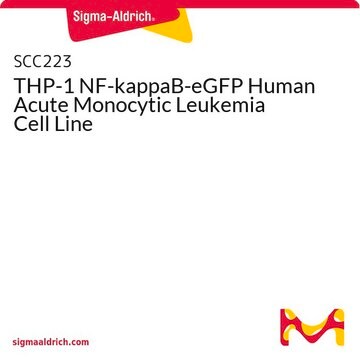SCC165
BLaER1 Human B-cell Precursor Leukemia Cell Line
Human
Sinónimos:
B cell Leukemia C/EBPalphaER clone 1
About This Item
Productos recomendados
product name
BLaER1 Human B-cell Precursor Leukemia Cell Line, BLaER1 human B-cell precursor leukemia cell line may be transdifferentiated and used to model human monocytes.
biological source
human
technique(s)
cell culture | mammalian: suitable
shipped in
ambient
General description
The BLaER1 cell line is a tamoxifen-inducible derivative of the RCH-ACV B-cell leukemia cell line genetically modified using a retrovirus vector to express C/EBPa fused with the estrogen receptor hormone binding domain (ER) and GFP . A study demonstrated that BLaER1 cells could efficiently convert into cells exhibiting increased adherent, phagocytic and quiescent properties with a transcriptome resembling normal macrophages . Cells retained their phenotype even when C/EBPa was inactivated, a characteristic of genuine cell reprogramming. C/EBPa induction also impaired cell tumorigenicity after transplantation into immunodeficient mice. BLaER1 is thus a model for highly efficient transdifferentiation of B-cell-derived human cancer cells.
Source:
BLaER1 cells are a single subclone isolated from C/EBPaER-GFP-transfected RCH-ACV acute lymphoblastic leukemia (ALL) cells sorted for GFP expression. The parental cell line was obtained from the bone marrow of a female with chromosome translocation 1;19 and trisomy 8 .
Biosafety Level 2:
BLaER1 cells contain squirrel monkey retrovirus (SMRV) and should be handled under biosafety level 2.
Cell Line Description
Application
Quality
- Each vial contains ≥1×10 viable cells.
- Cells are tested negative for infectious diseases by a Human Essential CLEAR panel by Charles River Animal Diagnostic Services.
- Cells are verified to be of human origin and negative for inter-species contamination from mouse, rat, chinese hamster, Golden Syrian hamster, and non-human primate (NHP) as assessed by a Contamination Clear panel by Charles River Animal Diagnostic Services
- Cells are negative for mycoplasma contamination.
- Cells tested positive for squirrel monkey retrovirus (SMRV).
Storage and Stability
signalword
Warning
hcodes
Hazard Classifications
Skin Sens. 1
Storage Class
12 - Non Combustible Liquids
wgk_germany
WGK 1
flash_point_f
Not applicable
flash_point_c
Not applicable
Certificados de análisis (COA)
Busque Certificados de análisis (COA) introduciendo el número de lote del producto. Los números de lote se encuentran en la etiqueta del producto después de las palabras «Lot» o «Batch»
¿Ya tiene este producto?
Encuentre la documentación para los productos que ha comprado recientemente en la Biblioteca de documentos.
Nuestro equipo de científicos tiene experiencia en todas las áreas de investigación: Ciencias de la vida, Ciencia de los materiales, Síntesis química, Cromatografía, Analítica y muchas otras.
Póngase en contacto con el Servicio técnico









